|
|

    
by Lyra Studios
|
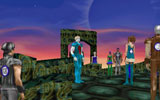 Massively multiplayer games have
been making the news lately. Sony recently announced their intentions to release a PS2
version of their online hit EverQuest-- a launch title for their online adapter package.
At the same time, a woman is suing the electronics giant in hopes of forcing them into
placing a warning label on the EverQuest box, after her son committed suicide while
supposedly suffering from an addiction to the game. Whether positive or negative,
misguided or not, online worlds are finding themselves more and more in the spotlight. And
so we have Underlight. Before Dark Age of Camelot (long before), or EverQuest, and only a
little after Ultima Online, Underlight was making its first appearance. In the online
world, Underlight was and is one of the underdogs of the genre, and as such, is great to
cheer for. In concept, Underlight functions along the same lines as many other online
games. Players log onto an Underlight server through the Internet, and are placed into a
world populated by other real life, living and breathing human representations. While
considered a granddaddy in computer terms, definitely not new, Underlight is an online
game that should conceivably evolve as the people playing it evolve. With my sleeves
rolled up, my best scanned picture handy incase I met anyone cute, I waded into the world
of Underlight to see what it had become in the last four years since its release back in
1998. In many respects what I found was an incredibly complex world with a unique concept
of itself and interesting ideology, a true role-playing experience and an online community
ready to help. In other respects what I found was an online world that has become outdated
in execution, holding its own only because it relies on the ever-resourceful (and
auto-updated) human players to keep itself alive. While resembling a modified chat group,
Underlight is a haven for intellectual conversations and legitimate role-playing, yet as a
game it will leave many players somewhat uninspired, unimpressed, and looking to one
another shrugging their shoulders as the question circulates, "Well, what do we want
to do now?" Massively multiplayer games have
been making the news lately. Sony recently announced their intentions to release a PS2
version of their online hit EverQuest-- a launch title for their online adapter package.
At the same time, a woman is suing the electronics giant in hopes of forcing them into
placing a warning label on the EverQuest box, after her son committed suicide while
supposedly suffering from an addiction to the game. Whether positive or negative,
misguided or not, online worlds are finding themselves more and more in the spotlight. And
so we have Underlight. Before Dark Age of Camelot (long before), or EverQuest, and only a
little after Ultima Online, Underlight was making its first appearance. In the online
world, Underlight was and is one of the underdogs of the genre, and as such, is great to
cheer for. In concept, Underlight functions along the same lines as many other online
games. Players log onto an Underlight server through the Internet, and are placed into a
world populated by other real life, living and breathing human representations. While
considered a granddaddy in computer terms, definitely not new, Underlight is an online
game that should conceivably evolve as the people playing it evolve. With my sleeves
rolled up, my best scanned picture handy incase I met anyone cute, I waded into the world
of Underlight to see what it had become in the last four years since its release back in
1998. In many respects what I found was an incredibly complex world with a unique concept
of itself and interesting ideology, a true role-playing experience and an online community
ready to help. In other respects what I found was an online world that has become outdated
in execution, holding its own only because it relies on the ever-resourceful (and
auto-updated) human players to keep itself alive. While resembling a modified chat group,
Underlight is a haven for intellectual conversations and legitimate role-playing, yet as a
game it will leave many players somewhat uninspired, unimpressed, and looking to one
another shrugging their shoulders as the question circulates, "Well, what do we want
to do now?" 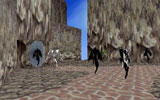 The Underlight world is one of the more unique available. It is, by definition,
a dream world. All the players are merely dreamers in an enlightened lucid dream, and when
they leave the game they are in actuality "waking up." This is the premise on
which Underlight in based, a change from the traditional Dungeons and Dragons theme that
is so common. One of the primary goals is to better understand the dream world itself,
studying the people in it, and the nature of the dream (whole quests are based on this
concept). Unlike other games, which revolve around action – fighting monsters and
finding items – Underlight encourages its players to occupy themselves almost
entirely with intellectual pursuits. Not that combat doesn’t exist, but it does so as
a secondary concern to evolving your knowledge, your social status, and your overall
social skill level. For this reason, there are no non-player characters, save the
occasional bad guy (nightmares), and even those can be played for a rather heavy fee.
Every character in the story is a person you can insult, befriend, or mock for their
ridicules fashion sense. The Underlight world is one of the more unique available. It is, by definition,
a dream world. All the players are merely dreamers in an enlightened lucid dream, and when
they leave the game they are in actuality "waking up." This is the premise on
which Underlight in based, a change from the traditional Dungeons and Dragons theme that
is so common. One of the primary goals is to better understand the dream world itself,
studying the people in it, and the nature of the dream (whole quests are based on this
concept). Unlike other games, which revolve around action – fighting monsters and
finding items – Underlight encourages its players to occupy themselves almost
entirely with intellectual pursuits. Not that combat doesn’t exist, but it does so as
a secondary concern to evolving your knowledge, your social status, and your overall
social skill level. For this reason, there are no non-player characters, save the
occasional bad guy (nightmares), and even those can be played for a rather heavy fee.
Every character in the story is a person you can insult, befriend, or mock for their
ridicules fashion sense.
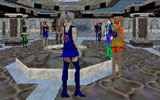 In
that respect, Underlight has a lot going for it. Speaking out of character by referring to
your real world self is heavily frowned upon by your fellow players (I quickly slipped
that photograph back into my wallet – good luck hitting on anyone who doesn’t
claim to be a fair skinned farm maiden with too short a skirt on). Quest boards, where you
seek out teachers and missions to increase your experience level, are filled with various
quests like, "Go find a man named so-and-so, and quiz him about his philosophical
beliefs on this or that subject, and then show me your ability to reason by telling me
your thoughts." Answering such quests allow you to learn new skills, similar to magic
spells, that expand your ability and power. Because of its heavy focus on the
intellectual, it quickly becomes evident that Underlight will appeal the most to people
who bring the imaginative world with them. In this way it takes on the feel of a graphical
chat room, in which most of the action is simply standing and talking, discussing, and
typing actions in the emote section of the screen. Aaron covers his mouth as he yawns
and stretches. In
that respect, Underlight has a lot going for it. Speaking out of character by referring to
your real world self is heavily frowned upon by your fellow players (I quickly slipped
that photograph back into my wallet – good luck hitting on anyone who doesn’t
claim to be a fair skinned farm maiden with too short a skirt on). Quest boards, where you
seek out teachers and missions to increase your experience level, are filled with various
quests like, "Go find a man named so-and-so, and quiz him about his philosophical
beliefs on this or that subject, and then show me your ability to reason by telling me
your thoughts." Answering such quests allow you to learn new skills, similar to magic
spells, that expand your ability and power. Because of its heavy focus on the
intellectual, it quickly becomes evident that Underlight will appeal the most to people
who bring the imaginative world with them. In this way it takes on the feel of a graphical
chat room, in which most of the action is simply standing and talking, discussing, and
typing actions in the emote section of the screen. Aaron covers his mouth as he yawns
and stretches.
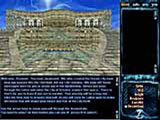 Though I like the concept behind the game, my
complaints with Underlight are numerous. While perhaps good when released four years ago,
Underlight’s graphics are barely commercial now, especially when compared with the
massive, free flowing, and diverse environments offered by competing products. All it
takes is a glance at the maps that ship with EverQuest to appreciate the shear size of the
world, yet Underlight is small enough that your character will always start in the same
location. In addition, most of the graphics, which remind me of Doom II, all look the same
regardless of what area of the world you’re in. There is no rain or seasonal changes,
no day or night that I encountered. The best Underlight offers is a slight change of
colors in clothing as a player passes in or out of a shadow. Unlike the vast, real world
feel of many of the other games out there, the Underlight world serves only as a place for
players to meet, not as a destination or exploratory element unto itself. Though I like the concept behind the game, my
complaints with Underlight are numerous. While perhaps good when released four years ago,
Underlight’s graphics are barely commercial now, especially when compared with the
massive, free flowing, and diverse environments offered by competing products. All it
takes is a glance at the maps that ship with EverQuest to appreciate the shear size of the
world, yet Underlight is small enough that your character will always start in the same
location. In addition, most of the graphics, which remind me of Doom II, all look the same
regardless of what area of the world you’re in. There is no rain or seasonal changes,
no day or night that I encountered. The best Underlight offers is a slight change of
colors in clothing as a player passes in or out of a shadow. Unlike the vast, real world
feel of many of the other games out there, the Underlight world serves only as a place for
players to meet, not as a destination or exploratory element unto itself.
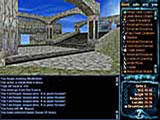 There
are some advantages to this, however. For example, almost any system will run Underlight.
The system requirements are light, and the entire game fits in a download under 25 megs.
This makes it very accessible to any level of gamer, unlike other games that require
graphics accelerators to even run. Still, it’s easy to get lost just because much of
the scenery looks the same. Items also lack pizzazz. They have names that are confusing in
their function -- what does a "Hazelnut gold turquoise charm" do, for example
– some items you can use, based upon your class of character, others you can’t.
Even those that you identify perform a limited number of things. One can make your
character invisible, another can heal you, another can shoot a ball of energy as an
alternative form of weapon. Still, I saw no indication that you could find additional
swords, or physical armor, clothing, or appearance modifiers--depth adding elements that
would normally be considered standard fair are ignored. There
are some advantages to this, however. For example, almost any system will run Underlight.
The system requirements are light, and the entire game fits in a download under 25 megs.
This makes it very accessible to any level of gamer, unlike other games that require
graphics accelerators to even run. Still, it’s easy to get lost just because much of
the scenery looks the same. Items also lack pizzazz. They have names that are confusing in
their function -- what does a "Hazelnut gold turquoise charm" do, for example
– some items you can use, based upon your class of character, others you can’t.
Even those that you identify perform a limited number of things. One can make your
character invisible, another can heal you, another can shoot a ball of energy as an
alternative form of weapon. Still, I saw no indication that you could find additional
swords, or physical armor, clothing, or appearance modifiers--depth adding elements that
would normally be considered standard fair are ignored.
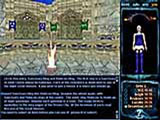 As a
consequence, what you see when you first enter the game, in terms of game play at least,
is what you get. Combat is rather simple, a matter of turning in circles around a monster
while swinging your knife. Though adequate, the combat wasn’t overly fulfilling and
wore thin quickly. As a
consequence, what you see when you first enter the game, in terms of game play at least,
is what you get. Combat is rather simple, a matter of turning in circles around a monster
while swinging your knife. Though adequate, the combat wasn’t overly fulfilling and
wore thin quickly.
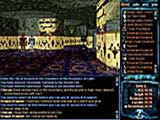 And
yet, despite all this, there are some players who simply love Underlight. The reason for
this is simple. If you enjoy the social structure, the art of interacting with others and
working your way up in the chain of command, Underlight has a very strong appeal. Since
there are no computer-controlled characters, all skills and promotions, level-ups and
such, come from "teachers", more experienced players that you communicate with
in order to advance. There isn’t a single role in the game that can’t be filled
by a player. Given time, one could become the ruler of one of the twelve pre-designed
houses that populate the land, with other players working under you, or become a poet or a
prophet, with followers hanging on your words. Think SCA. And
yet, despite all this, there are some players who simply love Underlight. The reason for
this is simple. If you enjoy the social structure, the art of interacting with others and
working your way up in the chain of command, Underlight has a very strong appeal. Since
there are no computer-controlled characters, all skills and promotions, level-ups and
such, come from "teachers", more experienced players that you communicate with
in order to advance. There isn’t a single role in the game that can’t be filled
by a player. Given time, one could become the ruler of one of the twelve pre-designed
houses that populate the land, with other players working under you, or become a poet or a
prophet, with followers hanging on your words. Think SCA.
Player killing is allowed, but not without a very good in-character reason for doing
so. For example, there are twelve different houses with different ideologies running
Underlight, between which a war has been waging for some time. Attacking another player in
order to fight for your house would be acceptable, but attacking a stranger for no reason
would not be. When death does occur, you merely become a body-less entity, unable to use
your weapons or skills. By returning to a place of sanctuary, you can proceed on with the
game. What evolves from this is a great potential to become fully involved in a very
complex social environment. Wars, intrigue, kidnappings, scandals; the players make the
world as they like it. This does, of course, leave you rather stranded if you log on and
no one is about. This happened to me once, when I logged on to find the world basically
empty of people. I entertained myself by sneaking into one of the house’s forbidden
castles, subsequently got lost trying to avoid people that weren’t even logged into
the game, and ended up quitting and restarting so that I wouldn’t have to work my way
back out again. In a world in which the real appeal is the people, it’s not very
interesting to be by yourself for long.
In the end, while Underlight has a great deal of potential in social interaction, I
can’t help but think that it falls short for the average gamer when compared to
EverQuest or Camelot. Though a fascinating chatting environment, as a game Underlight
doesn’t offer anything that isn’t equally offered in the prettier and much
larger universes offered by its competition. It attempts to give a gamer an experience
similar to those of the old home RPGs, driven by a living person as a game master.
Unfortunately, the software itself lacks the flexibility that is essential to that sort of
gaming. At roughly the same subscription price as the others ($9.95/month), Underlight is
not what most people will be looking for when they turn online for their entertainment.
There are elements that shine but many that don’t. Though I enjoy cheering for one of
the small companies in a very large and competitive world, Underlight has to be able to
show well in all areas in order to receive a good rating. Unfortunately, it doesn’t.
Still, it does do one thing that the others don’t. It’s free to try. The
Underlight website allows a user to download the software from the Internet, and try it
for a month for free. If you’re looking for a new chatting experience, or are
interested in a little true role-playing, swing by their site and download the client.
There are some of you who will find it truly addictive.
Aaron Stanton (05/02/2002) |
|
Snapshot
Ups: Old-school style MMORPG; lots of potential for living the dream; cool
dream world concept; good focus on social interaction and intelligent gaming; great for
RPG purists.
Downs: Just too technically deficient; not enough action.
Platform: PC
|
|
|
|
|
|
|
|
